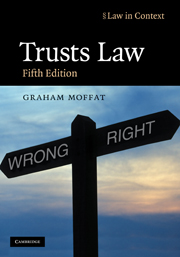Book contents
- Frontmatter
- Contents
- Preface to the fifth edition
- Acknowledgments
- Table of abbreviations
- Useful websites
- Table of statutes
- Table of statutory instruments
- Table of cases
- 1 Trusts introduced
- 2 The evolution of the private express trust
- 3 Taxation, wealth-holding and the private trust
- 4 Creating the trust – I
- 5 Creating the trust – II
- 6 Trusts and public policy
- 7 Flexibility in relation to beneficial entitlement
- 8 The taxation of private trusts
- 9 An introduction to trustees and trusteeship
- 10 Aspects of the management of trusts
- 11 Trusteeship, control and breach of trust
- 12 Implied trusts and the family home
- 13 Trusts in commerce I: occupational pension schemes
- 14 Trusts in commerce II: commerce and equitable remedies
- 15 Trusts in commerce III: commerce, credit and the trust
- 16 Trusts in commerce IV: fiduciary relationships, commerce and the trust
- 17 Trust, contract and unincorporated associations
- 18 An introduction to the law of charity
- 19 A legal definition of ‘charity’
- 20 The regulation of charities
- Index
6 - Trusts and public policy
- Frontmatter
- Contents
- Preface to the fifth edition
- Acknowledgments
- Table of abbreviations
- Useful websites
- Table of statutes
- Table of statutory instruments
- Table of cases
- 1 Trusts introduced
- 2 The evolution of the private express trust
- 3 Taxation, wealth-holding and the private trust
- 4 Creating the trust – I
- 5 Creating the trust – II
- 6 Trusts and public policy
- 7 Flexibility in relation to beneficial entitlement
- 8 The taxation of private trusts
- 9 An introduction to trustees and trusteeship
- 10 Aspects of the management of trusts
- 11 Trusteeship, control and breach of trust
- 12 Implied trusts and the family home
- 13 Trusts in commerce I: occupational pension schemes
- 14 Trusts in commerce II: commerce and equitable remedies
- 15 Trusts in commerce III: commerce, credit and the trust
- 16 Trusts in commerce IV: fiduciary relationships, commerce and the trust
- 17 Trust, contract and unincorporated associations
- 18 An introduction to the law of charity
- 19 A legal definition of ‘charity’
- 20 The regulation of charities
- Index
Summary
Introduction
An express trust satisfying the requirements of formality, certainty and complete constitution will be valid unless it contravenes certain overriding limitations which stem broadly speaking from public policy considerations. These limitations can be grouped for convenience into three categories. One category is concerned with attempts to use the trust format to defeat the claims of the creditors of settlors or beneficiaries or even the claims of one's spouse or partner when relationships break down. A second category comprises a loose class of prohibitions which cluster under the umbrella of public policy but are primarily concerned not to undermine accepted notions of morality and family solidarity. Trusts which might tend to interfere with the sanctity of marriage, for example, will be held void. The final category of limitations concerns the plane of time: while the law may place few restraints on the types of interest a settlor can create and the conditions to which they may be subject, restrictions are imposed through rules of perpetuity, accumulations and inalienability on the duration of trusts.
These limitations and their respective policy justifications form the subject-matter of this chapter.
At first sight, however, it must seem rather odd to devote a chapter to trusts and public policy, when a recurrent theme in the book is to weigh the rules of trusts law against non-legal policy considerations and to assess how the development of those rules has been influenced by such considerations.
- Type
- Chapter
- Information
- Trusts LawText and Materials, pp. 267 - 322Publisher: Cambridge University PressPrint publication year: 2009



